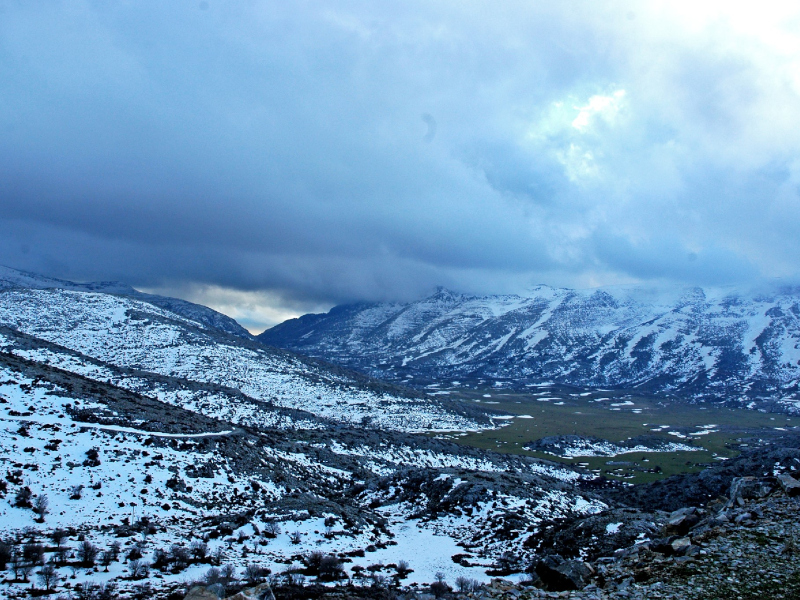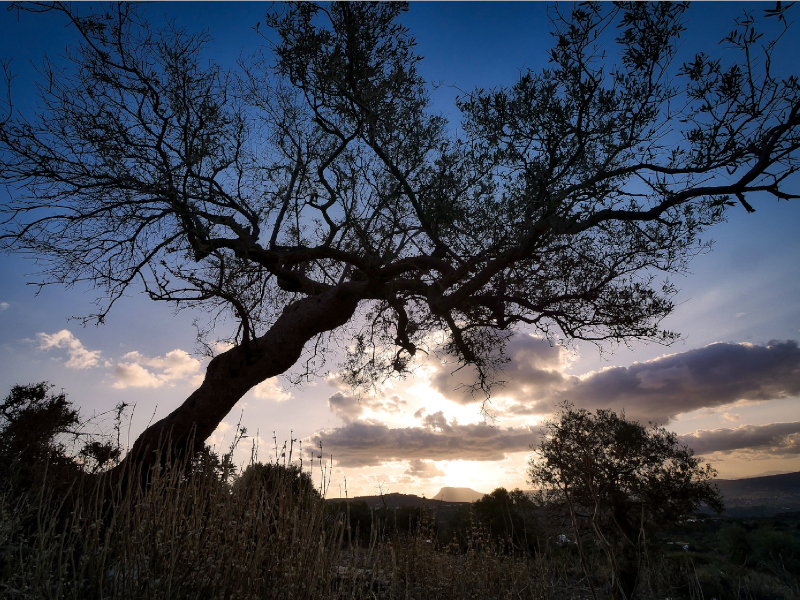Rethymno is a region where the wild mountainous landscape alternates with the fertile lowlands and the imposing rocky coastline with the endless sandy beaches, creating a landscape of distinct beauty. Apart from the canyons and the caves that are individually presented, we have selected some areas of exceptional natural beauty which are significant for the visitors to find out and enjoy.
Preveli Lake
At the mouth of the Mega River, where the imposing Kourtaliotikos Gorge ends, is located the famous Lake Preveli or Phoenix beach. To get there you just need to follow the road to the Preveli Monastery and turn left on a dirt road just before arriving at the monastery, then park at the end of the road. Following you have to walk up to the sandy beach which is actually compensates the visitor as it looks like a tropical scenery full of palm trees. The stream flowing into the sea and the wild vegetation create a wonderful setting that everyone has to enjoy.
Nida Plateau
79 km from Rethymno in the area of Psiloritis, there is the famous Nida Plateau, where the cave Ideon Andron hosted the newborn Zeus.
In Nida, which is used as a pasture in the summer, one can admire the famous Mitata, the stone vaulted buildings where shepherds live. There is also a ski center in Nida which operates during the winter.
Argyroupolis
Gorges
Kourtaliotiko gorge
The gorge of Kourtaliotis with the imposing slopes that reach a height of 600 meters, starts from the village of Koxare and ends at the Preveli lake. It is a wonderful gorge worth visiting.
Following the steps at the side of street Koxare – Asomatos, you reach the bottom of the gorge where the church of Agios Nikolaos is located. The gorge is crossed by the Big River, which is called Kourtaliotis at this point.
Kotsyfos Gorge
The gorge of Kotsyfos starts at Kanevos village and ends at Plakias. The starting point is very narrow with a width of about 10m which gradually increases and reaches 600 m. Its total length is 1.800 m, and the almost vertical sides reach a height of 600m. Inside the gorge there is a small temple, built inside a rocky cavity.
Patsos Gorge
Arkadi Gorge
Prassano Gorge
Caves
The most famous caves in the prefecture are Gerani and Simonelli to the west of the city, Agios Antonios in Patsos Amariou, Melidoni, Ideon Antron, the cave in Mougri Sison, the cave S(f)endoni in Zoniana etc..
Ideon Antron
Ideon Antron is located on the eastern slopes of Mount Ida (Psiloritis), in the plateau of Nida
The distance of the cave from Anogia is 24km and from Rethymno it’s 78km.
It is situated at an altitude of 1538 m with a huge entrance which impresses every visitor in the first place. The cave is outsized with a large central hall and a side tunnel of 22 m long. According to the legend, Zeus was grown up in the cave so it became an important worship center in both Minoan and Roman times. The findings of the interior excavations which are still in progress include important findings among them pottery, gold jewellery, metal objects and also the famous bronze shields. Due to the excavations in progress the cave is not accessible to the public.
Melidoni Cave
The excavation research still carried out in the Melidoni cave indicate that it had been inhabited continuously as a worship center from the early late Neolithic Era till the Roman period. According to inscription evidence it was related with the worship of Hermes. Moreover, the cave has played a tragic role in the history of Cretan revolution against the Turks, when 370 inhabitants of Melidoni died in the cave from asphyxiation caused by smoke in January of 1824. In the first chamber of the cave, there has been placed an ossuary with the bones of heroes. The cave is open to visitors.
Gerani Cave
In the cave of Gerani with the magnificent stalagmite decoration and the 6 chambers, according to archaeological research, were found besides the three human skeletons, also a number of bone and stone tools of the Neolithic Age. Bones were also found, belonging to over one hundred native deer that must have died at the end of the Pleistocene Era. Apparently the three human skeletons found in the cave since they were trapped inside probably because of an earthquake.
Sfendonis Cave
Sfendoni Cave of Zoniana village in Mylopotamos (47 km from Rethymno on the road Rethymno – Parama – Axos) has many stalactites and stalagmites of different colours and shapes which decorate the 14 rooms of the cave. Its length is 550 m and its total surface covers 3,330 sqm. In recent years archaeological research has identified a Neolithic settlement in the cave. The cave is open to visitors.
Agios Antonios Cave
The cave of Agios Antonios in Patsos represents one more cave with a worship atmosphere since it has been proven by archaeological research that was an important center of worship from Late Minoan to Roman times. According to inscription, within the cave was worshiped by Hermes Kraneos. The church in the cave is dedicated to Saint Anthony, the protector of the children. The cave is open to visitors.
Fauna
In the coastal zone and even on the rocky shores nests the famous Gull and Falcon (Falco Eleonore) that comes to Crete from Africa during the summer while the sea turtle caretta – caretta lay its eggs on the sandy beaches.
In the lowland area, in the plains and low hills, there are rabbits, ferret badgers, hedgehogs, field rats (Apodeus sylvaticus-creticus), bats and birds such as sparrows (Passer domesticus), goldfinch (Carduelis carduelis), swallows (Delichon urbica), crows (Corvus corone), finches (Fringila coelembs) and others.
The same species of animals and birds found more often in the semi-mountainous area. Furthermore, other predatory birds exist such as crows (Corvus corax) and blackbirds (Turbus merula).
The paradise of predatory birds, such as bearded vulture (Gyapetus barbatus) and all the previous, is the mountain areas. There also lives the rare Cretan wild goat (Capra aegagrus) and the Cretan wildcat (Felix silvestris).
Flora
It is estimated that there are about 2000 plant species, 160 of those are endemic and grow exclusively on the island.
In the plains that go as high as 300 m, one can find Mediterranean makia bushes, such as Lentisks (Pistacia lentiscus) and Hollies (Quercus coccifera) as well as Oleander (Nerium oleander), Wicker (Vitex agnus- castus), Chamomile (Chamomilla recutita), Mint (Mentha spicata), Myrtle (Myrtus communis), Heather (Erica), “Stafilinakes” (Daucus carota), Wild celeries (Smyrnium), Tree Mallows (Alcea pallida cretica), common poppies (Papaver rhoeas), “Ladania” (Cistus incanus-creticus) and Cretan ebonies (Ebenus cretica).
The semi-mountainous area goes up to a height of 800 m and includes mostly bushes such as Hollies (Quercus coccifera), Lentisks (Pistacia lentiscus), Thymes (Thymus capitatus), Arbutuses (Arbutus unedo), “Agarathos” (Phlomis cretica), Maples (Acer sempervirens), Bryonies (Bryonia cretica), Sedges (Spartium junceum), Styrax (Styrax officinalis) etc., as well as wild flowers, such as the Cretan arum (Cyclamen creticum), Garden flags (Iris cretica), Dragon lilies (Dracungulus), Erianthus (Gladiolis italicus), Tulips (Tulipa orphanidea), Bulb flowers (Muscari commosum), various Cretan orchid species and trees, such as locust trees (Ceratonia siliqua) and oak trees (Quercus).
On the mountainous zone that spreads between a 800 m and 1800 m altitude, there are Hollies (Querus coccifera) and Cretan maples (Acer sempervirens) as well as bushes and wild flowers, such as Yellow violets (Erysimum creticum), Tulips (Tulipa cretica), Cretan achilleas (Achillea cretica), Wild violets (Viola cretica), Crocuses (Crocus Oreocreticus) etc.
Gorges have rich flora and are real heavens with wild flowers and bushes, many of which are endemic and rare. since the wild and inaccessible location protect them from the human factor.
The Olive tree
The prefecture of Rethymno boasts an abundance of olive groves and the production of olive oil is one of the inhabitant’s main occupation. The species of olives that are cultivated are mainly “chondrolies”, “koroneikes” and a few “tsounates”. These varieties produce olive oil as well as edible olives of excellent quality. The famous olive grove near Adele in the Municipality of Arkadi, which stretches in a vast lowland and semi-mountainous area, is considered one of the largest olive groves in the Mediterranean.
The area of Rethymno and generally the entire island of Crete has always been closely related with the olive tree and the production of olive oil.
On the grounds of this long-lasting relationship a Museum of the Olive-tree was founded in the settlement of Kapsaliana, which was formerly a dependency of the Arkadi Monastery. At this place the Monastery’s oil press as well as other buildings were established towards the end of the 16th and in the beginning of the 17th century. Today the settlement has almost entirely been restored and preserved.

















